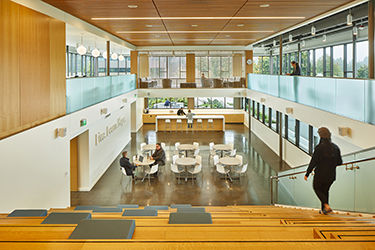|
Subscribe / Renew |
|
|
Contact Us |
|
| ► Subscribe to our Free Weekly Newsletter | |
| home | Welcome, sign in or click here to subscribe. | login |
Real Estate
| |
 |
May 27, 2021
Meeting the SE 2050 Challenge
PCS Structural Solutions

Jeseritz
|
What is SE 2050?
The Structural Engineers 2050 Challenge (SE 2050) is an initiative designed to educate, engage and measure progress toward net-zero buildings by 2050. The challenge supports the target set by the Paris Climate Agreement to limit the increase of global temperatures well below 2 degrees C. According to the University of Washington’s Carbon Leadership Forum, “the SE 2050 initiative challenges structural engineers to meet embodied carbon benchmarks and increasingly higher reduction targets in a ‘race towards the most efficient building’ as we approach the year 2050.”
The reduction of embodied carbon in structural elements is one of the key strategies towards contributing to a resilient urban built environment.
EMBODIED CARBON
Since the advent of the Leadership in Energy and Environmental Design rating system, the Living Building Challenge, and Passive House, much of the emphasis has been on reducing the operational energy consumed by a building during occupancy. As buildings become more energy efficient and achieve net-zero energy consumption, interest is shifting to tackle the environmental impact of a building’s structure, exterior envelope and interior finishes.
These systems’ effects on the environment are measured by a material’s associated embodied carbon (EC) — the total impact of all greenhouse gases emitted (measured in CO2 equivalent) into the atmosphere by a material, product or system. For structural materials, EC is linked primarily to the extraction of the raw material, manufacturing, transportation, construction, maintenance, demolition and end life of the material.
The impact of a building’s construction and operations on carbon emissions has been well established by the AEC community. “Buildings, in fact, contribute 40% of the CO2 emissions worldwide,” according to the Carbon Leadership Forum.
Architecture 2030 reports: “To accommodate this tremendous (population) growth, we expect to add 2.48 trillion square feet of new floor area to the global building stock, doubling it by 2060. This is the equivalent of adding an entire New York City every month for 40 years.”
With the amount of building construction anticipated to occur over the next several decades and understanding of their associated environmental impacts, it is paramount that the AEC community begins to address and actively work toward EC reductions.
Sustainable building programs such as the United States Green Building Council’s LEED, International Green Building Initiative’s Green Globes, and Living Future Institute’s Zero Carbon Standard are beginning to include points and design guidelines that measure, quantify and reduce a building’s embodied carbon.
To reduce our structural designs’ impacts, we must first quantify EC. With advancing tools to measure EC, structural engineers can provide clients, building owners, and local/national governments constructive strategies to mitigate the environmental impacts of a building’s structural system. Through the use of Whole Building Life-Cycle Assessment tools, which measure the environmental impacts of materials from extraction (cradle) to disposal (grave), or product tools that measure impacts from cradle to gate (before a product is transported to the consumer), we can quantify our systems’ EC impacts. These tools help structural engineers spot high embodied carbon areas in our design and offer clients and owners active solutions to mitigate their associated embodied carbon.
Embodied carbon data reported by PCS and other commitment program partners to the SE 2050 database will be used to help track embodied carbon in the industry, set industry benchmarks and establish reduction targets. The database is a powerful step toward effective change.
ECAP
SE 2050 coalition partners commit to educating staff, developing reduction strategies, and advocating for embodied carbon reduction on their projects. Each partner firm develops an internal Embodied Carbon Action Plan (ECAP) that informs how these goals are reached within the firm. In addition to serving as a roadmap, the ECAP development process is important for the evolution of the firm culture as it embraces sustainable principles and recognizes its role in affecting meaningful change in the industry.
ECAPs will be publicly available for viewing and will provide transparency on the goals and achievements of SE 2050 signatory firms.
STRUCTURAL ENGAGEMENT
New tools and a growing body of information positions structural engineers to engage and impact progress toward net-zero embodied carbon building. Early structural project engagement is key, however. Getting critical metrics and recommendations in front of the design team early in the project allows the team to make intentional project choices to maximum benefit. In the race toward efficient building, it’s all hands on, and collaboration is an important tool toward achieving embodied carbon reduction benchmarks.
Chris Jeseritz of PCS Structural Solutions is Sustainability Committee chair.
Other Stories:
- Coming soon: A surge of TODs in the Bel-Red corridor
- The many shades of green
- Regional growth: Towns, small cities should choose to lead or be led
- Our city, our time
- Sustainable urban design: connecting community and nature
- Placemaking in pocket parks: Sustaining authenticity in growing urban neighborhoods
- Little houses everywhere: How ADUs will reshape the urban fabric
- Coming soon: A surge of TODs in the Bel-Red corridor
- Making changes that last generations
- Diverse spaces are key to returning urban cores to normal
- Preparing for Bellevue’s dynamic future
- Infinity Shore Club shows resilience of Seattle market



